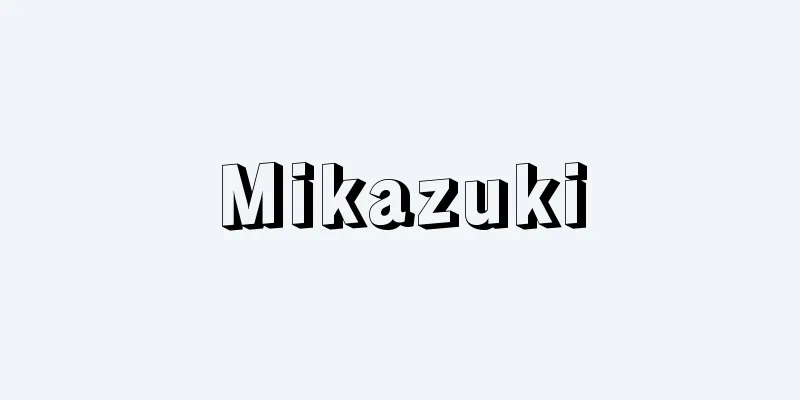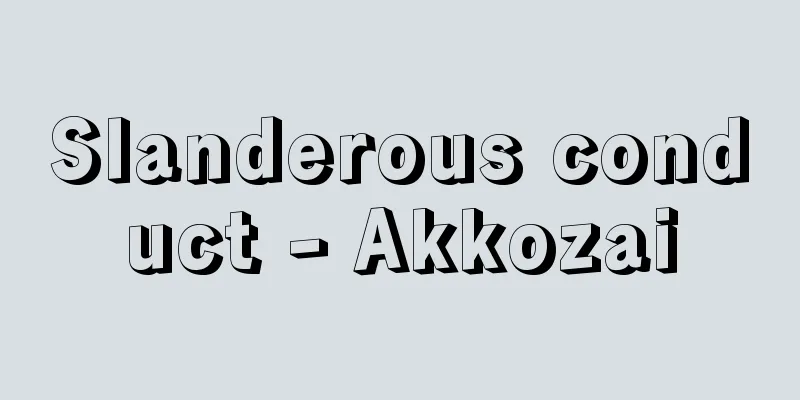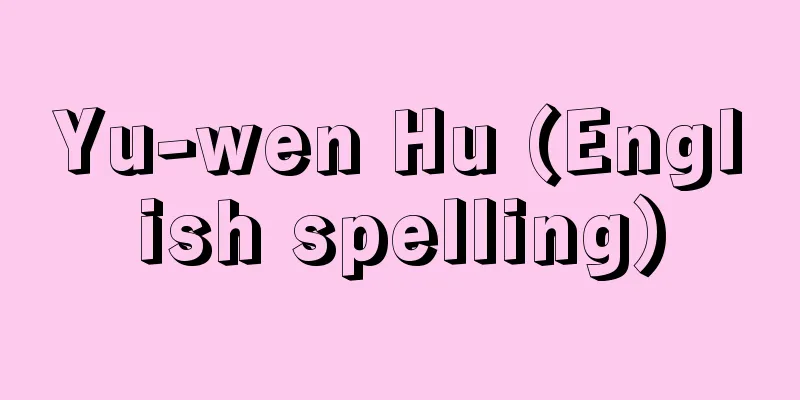Physical education - Taiiku (English spelling) physical education

|
Etymologically, it means "education of the body." From its origin, it means "education for building psychologically, mentally, and socially healthy bodies of children and students in schools, which are educational institutions." Therefore, traditionally, it refers to physical education in schools (physical education classes as a subject or health and physical education classes). However, there are also extracurricular sports activities in school life, and in a broader sense, it also includes education in these sports activities. All of these are collectively called "school physical education." School physical education refers to education that grasps the influence of physical exercise on human development from various perspectives based on various phenomena, teaches exercise and play itself, and at the same time, uses exercise and play, including sports, as teaching materials to deepen human perception-motor behavior ability and cultural awareness, and helps students understand the meaning of exercise and what health is for humans. Etymologically, sports are activities that belong to the category of play, but they also contain competitive elements and are self-challenging. They also have a world of freedom and creativity in terms of self-determination. Therefore, if one strongly seeks self-cultivation and the training of will in sports activities that include competition and cooperation, it becomes sports education, which becomes physical education in the broad sense. In this way, "physical education" can be interpreted in either a broad or narrow sense, depending on how one grasps the cultural meaning of the body and movement. [Yutaka Sato] The origins of physical educationThe relationship between human beings and physical exercise and sports techniques in human history began with the development of tools and techniques for hunting and farming in the primitive age, and has developed from the practical application of physical activity in daily life to the recreational use of exercise, and further to the culturalization of sports and human education. The emergence of physical education in world history dates back to the period (4000 BC) when sports activities such as swimming, dancing, hunting, gymnastics, wrestling, acrobatics (acrobatics), and ball games existed in Egypt, and swimming, archery, and horse riding in Mesopotamia. Later, in Greece, tomb games, events to welcome state guests, and leisure activities were formed as a culture (around 776 BC). Here, sports competitions were held as part of festivals, and the polis (city-state) placed importance on the education of young people, leading to the emergence of the first school physical education in history. It can be said that physical education in Greece was positioned as a method and educational content for building an ideal nation. In China, education began in the Yellow River basin, and during the Han Dynasty the Six Arts (ritual, music, archery, rule, calligraphy, and mathematics) were considered essential to upper class society, and archery and rule (horse riding) in particular were considered martial arts in social roles and an aid to spiritual cultivation (around 551 BC). [Yutaka Sato] School AthleticsThe establishment of school physical education dates back to 1774, when the German Philanthropist Basedow introduced physical education as a subject for children at his Philanthropic School. At that time, physical education consisted of discipline-oriented events such as dancing, horse riding, outdoor walks, running, wrestling, and swimming. Later, in Europe, German and Swedish gymnastics were developed as core teaching materials, while in the UK, football was used to develop character development. In response to these, the US developed its own physical education system in 1920, developing scientific sports and recreation education linked to health education and health work. Meanwhile, in the Soviet Union, in 1918, a physical education system for work, production, and defense was developed in order to build a socialist state. In Japan, "taijutsu" was adopted with the promulgation of the school system in 1872 (Meiji 5), and the name was changed to "taiso" the following year. In 1886, the School Act was enacted, and the era of regular and military-style gymnastics began. However, with the rise of nationalism and the Sino-Japanese and Russo-Japanese wars, martial arts such as kendo and judo became teaching materials for training the mind and body in addition to gymnastics, and they were adopted in junior high schools and normal schools (for boys). In the Taisho period, the School Gymnastics Instruction Guidelines were enacted (1913), and Swedish gymnastics, games, sports, and training were added, and six hours of gymnastics were held every week. The tragedy of the wartime system of physical education began with the implementation of national defense competitions in 1938 (Showa 13) and the physical fitness badge examination (1939). The Ministry of Health and Welfare, including the Physical Fitness Bureau, was established (1938), and the National Physical Fitness Law was enacted (1940), and the country entered into World War II. He then dissolved the Dai-Nippon Athletic Association and other sports organizations, and established a system of support for the Imperial Rule centered on the newly established Dai-Nippon Athletic Association and Dai-Nippon Butokukai, promoting the nationalization of sports, the transformation into battlefield sports, and the practical application of martial arts. In addition, the names of Western-style sports were adapted into Japanese, and in connection with the enactment of the National School Act, with the aim of nurturing Imperial citizens and improving national defense capabilities, the name of the school subject was changed to "physical training," and sports were militarized. With the end of the Second World War in 1945, the country rebuilt its education system with the aim of peace and democratization. Martial arts, which had become a means of offensive combat under the wartime Imperial ideology, and sports that had become combat techniques were wiped out, and school physical education was born (1947), which aimed for peace, health, and happiness. The School Physical Education Guidelines are historical in this respect. The names of the combined subjects "Physical Education" (elementary school) and "Health and Physical Education" (junior and senior high school) were created at this time, and health and physical education became compulsory at universities in 1949. School physical education as a subject aims to (1) develop the various organs of the body, (2) improve motor skills, (3) develop sociality, and (4) cultivate awareness and attitudes towards exercise and health. For this reason, the curriculum is revised approximately every 10 years and the educational content is reviewed at each school level, taking into account the development of children and students, the changing and evolving social demands, and scientific progress. Currently, the content is organized in a mutually interrelated manner from two fields: physical education and health. [Yutaka Sato] Social sportsEtymologically, it refers to sports and recreation, and is interpreted as synonymous with the relationship between social education and school education. Therefore, social physical education is defined as "organized educational activities (including physical education and recreational activities) conducted primarily for young people and adults, excluding educational activities conducted as part of the school curriculum based on the School Education Law" (Article 2 of the Social Education Law). In modern society, the concept and scope of physical education has expanded, and with the development of mass media in conjunction with advances in science and technology, sports to play and sports to watch have become more accessible to people through information, and sports and recreation are rapidly becoming more popular. On the other hand, in relation to social welfare issues, a wide range of physical education has been developed that also considers health management after graduation, from physical education to energize people with physical and mental disabilities and those with congenital developmental disabilities, to "lifelong physical education" that includes elderly people whose motor functions decline with age. In addition, workplace physical education has been organized as a diverse form of activity to manage health and safety in the workplace, and community sports have been organized to promote the health of local residents. The foundations for the development of social sports after the Second World War include the holding of the National Athletic Meet (1946), the promulgation of the Labor Standards Act (1947), the resumption of radio calisthenics broadcasts (1951, 1952), a notice from the Vice Minister of Education on the promotion of local sports (1957), the implementation of National Sports Day (1958), the enactment of the Sports Promotion Act (1961), the establishment of Sports Day (1966; from 2020 it will be called Sports Day), and the training of sports instructors in local communities. West Germany's Golden Plan, which was developed in 1961 as a plan to expand sports facilities, had a major impact on Japan's social sports facilities and their implementation plans as a policy to promote physical education and sports that would allow all citizens, young and old, male and female, to enjoy the joys of life through health and recreation. In particular, the Zweiter-Weg (Second Way), the German Sports Federation's Sports Charter (1966), and the Trimm Aktion played a fundamental role as the foundation for social welfare and national health in Japan in terms of how to spread sport and recreation to each and every citizen. In this way, sports education activities outside of schools, which are independently undertaken by private organizations and local public organizations, are called social physical education. Such social physical education activities are likely to develop in a diverse manner in the future in line with the Sports Promotion Act and popularization. The educational content of school physical education is selected and constructed based on the learning value that lies within various physical games and sports. On the other hand, the educational content of social physical education is expected to develop the basic movements and knowledge acquired in school physical education, turn them into games or activities, and place value on cultural development and creative activities through daily life and socialization. [Yutaka Sato] Linkage between school and community physical educationToday, school physical education and community physical education, which had been divided into two, have entered a new stage of reform, considering the functions of each as mutually complementary, and regarding the interrelationship of the community, school, and family. In response to this social trend, the Ministry of Education (now the Ministry of Education, Culture, Sports, Science and Technology) revised the curriculum guidelines for elementary, junior high, and high schools in 1998-1999. According to the new curriculum guidelines, in the compulsory education stage, "health" was added to physical education in elementary schools with the aim of creating the foundation for a lifelong, active life. In junior high schools, the field of physical education has been reorganized into a group of sports, and a selection system has been introduced, with content designed to help students recognize the characteristics of exercise, how to learn, and the effects of physical fitness and exercise through practice. In the field of health, emphasis is placed on connection with nature, and mental health and stress response are emphasized, as well as "the ability to develop oneself." In particular, with a focus on the relationship between physical education and sports, the new curriculum guidelines exclude "club activities" from the area of special activities, strengthen local sports club organizations, and aim to link school physical education and community physical education. As we have seen, physical education and sports are closely related, but in cutting-edge elite sports, "professionalization" is progressing in pursuit of the best records and winning and losing, and with the dramatic advances in exercise technology and training science, unhealthy doping through drug administration and other body modification are being carried out, and the current situation is that the gap and contradiction between the technological development of cutting-edge sports and popular sports that seek health is increasing more and more. This issue is also a major challenge imposed on us in the 21st century in terms of considering "what physical education and sports are for humans." [Yutaka Sato] "Modern Sports Encyclopedia" edited by the Japan Amateur Sports Association (1970, Taishukan Shoten)" ▽ "Encyclopedia of Physical Education Science" edited by Ikai Michio, Ebashi Shintaro, Iizuka Tetsuo, and Takaishi Masahiro (1972, Daiichi Hoki Publishing)" ▽ "Encyclopedia of Educational Studies" edited by Hosoya Toshio, Okuda Masatake, and Kono Shigeo (1978, Daiichi Hoki Publishing)" ▽ "Modern School Physical Education Encyclopedia" new edition edited by Matsuda Iwao and Uto Masahiko (1981, Taishukan Shoten)" ▽ "Modern Lesson Study Encyclopedia" edited by Yoshimoto Hitoshi (1987, Meiji Tosho Publishing)" ▽ "Encyclopedia of School Physical Education Lessons" edited by Uto Masahiko, Sakata Naohiko, Takahashi Takeo, and Hosoe Fumitoshi (1995, Taishukan Shoten)" ▽ "Postwar Physical Education Practice Theory" edited by Nakamura Toshio, volumes 1-3 (1997-1999, Sobun Kikaku)" ▽ "Matsuoka Shigenobu (ed.), "Basic Knowledge of 300 Important Terms in Health, Physical Education and Sports Education" (1999, Meiji Tosho Publishing)" ▽ "Sugimoto Atsuo (ed.), "For Students of Physical Education Education" (2001, Sekai Shisosha Publishing)" [References] | | | | | | | | | | | | | | | |Source: Shogakukan Encyclopedia Nipponica About Encyclopedia Nipponica Information | Legend |
|
語源からいえば「身体(からだ)の教育」。発生からいうと「教育機関である学校における児童・生徒の心理的、精神的、社会的に健康な身体(からだ)づくりの教育」。したがって、伝統的には学校における体育(教科としての体育科または保健体育科の授業)をさしている。しかし学校生活においては課外のスポーツ活動もあり、広義にはこれらのスポーツ活動における教育も含まれている。こうしたものを総称して「学校体育」といっている。学校体育は、身体運動が人間形成に及ぼす影響をさまざまな現象から多角的にとらえ、運動や遊戯そのものを教えると同時に、スポーツを含む運動や遊戯を教材にして、人間の知覚―運動行動能力や文化認識を深め、運動することの意味や人間にとって健康とは何かを理解させていく教育をさしている。 スポーツは語源的に遊戯の類(たぐい)に属する活動であるが、競争的要素を含み自己課題的である。また自己決定という点において自由と創造的世界をもっている。したがって、競争や協同を含むスポーツ活動のなかに自己陶冶(とうや)や意志の訓育的意味を強く求めるとスポーツ教育sports educationとなり、広義の体育となる。このように、「体育」は身体や運動の文化的意味のとらえ方によって、広義にも狭義にも解釈されている。 [佐藤 裕] 体育の発祥人類の歴史における身体運動や運動技術と人間のかかわりは、原始時代の狩猟、農耕の道具や技術の発展に端を発し、身体活動の生活化・実用化から運動遊戯化へ、さらにスポーツの文化化や人間教育へという発展の経緯をたどっている。世界史における体育の発生は、エジプトの水泳、ダンス、狩猟、体操、レスリング、軽業(かるわざ)(曲芸)、球戯、メソポタミアの水泳、弓射、馬術などのスポーツ的活動の存在期(前4000)に端を発する。その後ギリシアの墓前競技、国賓歓待行事、余暇活動が文化として形成される(前776ころ)。ここでは祭礼にスポーツ競技が行事の一環として実施され、ポリス(都市国家)が青少年教育を重視し、史上最初の学校体育を出現させた。ギリシアの体育は理想国家建設のための方策、教育内容として位置づけられていたといってよい。 中国では黄河流域から教育が開け、漢の時代に六芸(りくげい)(礼・楽・射・御・書・数)が上流階級社会に必須(ひっす)とされ、とくに射・御(乗馬)は社会的職分としての武技とされ、精神陶冶の一助とされた(前551ころ)。 [佐藤 裕] 学校体育学校体育の成立は、1774年にドイツの汎愛(はんあい)派のバゼドウが汎愛学院Philanthropiumで児童に体育を教科として採用したことに始まる。当時の体育としては、ダンス、乗馬、野外散歩、駆け足、レスリング、水泳などの鍛錬的種目を採用した。その後、ヨーロッパではドイツ体操やスウェーデン体操などの中心教材を発展させ、イギリスではフットボールによる人間形成を発展させた。アメリカではこれらを受けて1920年に独自の体育体系を育て、健康教育、保健事業と関連させた科学的なスポーツ・レクリエーション教育を発展させた。他方、ソビエト連邦では1918年に社会主義国家建設のため、労働―生産―防衛のための体育体系を発展させた。 日本では1872年(明治5)の学制発布により「体術」が採用され、翌年に「体操」という名称に変わった。1886年には学校令の制定があり、普通体操、兵式体操時代に入るが、日清(にっしん)・日露戦争に伴って富国強兵論、国家主義が台頭し、体操に撃剣、柔術などの武術が心身鍛錬の教材となり、中学、師範(男子)学校に採用された。大正期に入って学校体操教授要目が制定され(1913)、スウェーデン体操、遊戯、スポーツ、教練が加えられ、毎週6時間実施された。体育の戦時体制化の悲劇は1938年(昭和13)の国防競技、体力章検定の実施(1939)に始まる。体力局を含む厚生省の新設(1938)によって国民体力法が制定され(1940)、第二次世界大戦に突入する。そして、大日本体育協会、スポーツ団体を解散し、新設の大日本体育会、大日本武徳会などを中心とした翼賛体制を確立し、スポーツの国粋化、戦場運動化、武道の実戦化を推進した。また洋式スポーツ名称は日本語化され、国民学校令制定に関連して皇国民の育成と国防能力の向上を目ざし、教科名を「体錬科」と改め、スポーツの軍事化を行った。 1945年(昭和20)第二次世界大戦終結により平和・民主化による教育再建が行われ、戦時中の皇国思想を背景とする攻撃戦闘の手段と化した武道や、戦技化されたスポーツが一掃され、平和・健康・幸福を目ざした学校体育が誕生する(1947)。学校体育指導要綱はこの点で歴史的意味をもつ。「体育」(小学校)、「保健体育」(中・高等学校)の合教科(合体した教科)名称ができたのはこのときからで、大学では1949年に保健体育が必須化された。教科として行われる学校体育は、(1)身体諸器官の発達、(2)運動技能の向上、(3)社会性の発達、(4)運動、健康認識や態度の育成、を目ざしている。そのための教育課程がそれぞれの学校段階において、児童・生徒の発達や変動し発展する社会的要請や科学の進歩を踏まえながら、およそ10年ごとに指導要領を改訂して教育内容の検討が行われている。現在では体育領域と保健領域の2分野から相互関連的に内容が編成されている。 [佐藤 裕] 社会体育語源的にはスポーツ・レクリエーションをさし、社会教育と学校教育との関係と同義に解される。したがって社会体育は「学校教育法に基き、学校の教育課程として行われる教育活動を除き、主として青少年及び成人に対して行われる組織的な教育活動(体育及びレクリエーションの活動を含む)をいう」(社会教育法2条)とされている。 現代社会においては体育概念も領域も拡大され、科学技術の進歩に伴うマス・メディアの発達により、やるスポーツ、見るスポーツともに人々の身近に情報化が進み、スポーツ・レクリエーションの大衆化が急速に進行している。他方では社会福祉問題にも関連し、心身障害者をはじめ先天的に発達を阻害された人々に活力を賦与するための体育、加齢とともに運動機能の減退していく高齢者までも含めた「生涯体育」まで、学校卒業後の健康管理をも考えた幅広い体育が展開されている。また職場の健康安全管理といった側面では職場体育が、地域住民の健康推進のためには地域スポーツが多様な活動形態として組まれている。こうした第二次世界大戦後の社会体育の発展基盤としては、国民体育大会の開催(1946)、労働基準法の公布(1947)、ラジオ体操の放送再開(1951、1952)、地域スポーツの振興についての文部次官通達(1957)、国民体育デーの実施(1958)、スポーツ振興法の制定(1961)、体育の日の制定(1966。2020年からの呼称はスポーツの日)をはじめとし、地域社会のスポーツ指導員の育成などがあげられる。1961年を基年にスポーツ施設の拡充計画として展開された西ドイツのゴールデンプラン(黄金への道)は、老若男女すべての国民が健康・レクリエーションなど人生の喜びを味わえる体育・スポーツ振興政策として、日本の社会体育施設ならびにその実行計画に多大の影響を与えた。とくに第二の道Zweiter-Weg、ドイツ・スポーツ連盟のスポーツ憲章(1966)、トリム運動Trimm Aktionは、国民ひとりひとりにスポーツ・レクリエーションをどのように浸透させるかという点で、日本における社会福祉や国民の健康の基礎として原形的役割を果たした。 このようにスポーツ教育運動を学校以外で民間団体、地域公共団体などが主体的に取り組む活動を社会体育とよんでいる。こうした社会での体育活動は、スポーツ振興法や大衆化に伴って今後多様に発展する傾向にある。学校体育の教育内容は、種々の運動遊戯やスポーツのなかに潜む学習性の価値によって選択構成される。一方、社会体育の教育内容は、学校体育で獲得した基礎的な運動や知識を発展させ、遊戯化あるいは活動化し、生活化・社会化を通した文化発展や創造的活動をするところに価値が求められるようになっている。 [佐藤 裕] 学校体育と社会体育の連係今日、これまで二分されていた学校体育と社会体育は、それぞれの機能を相互補完関係で考え、地域・学校・家庭を相互関連的にとらえた新しい組織化の改革段階に入った。こうした社会的動向にしたがって、文部省(現文部科学省)は1998年(平成10)~1999年に小・中・高校の学習指導要領の改訂を行った。新学習指導要領によると、義務教育段階において、小学校では生涯を通じて活力のある生活を送る基礎をつくることを目的として、体育に「健康」が加えられた。中学校では、体育分野は運動領域群を整理して選択制を導入し、運動の特性や学び方、体力づくりと運動の効果を実践を通じて認識させるよう内容構成している。また、保健分野では、自然とのかかわりを重視し、心の健康、ストレスへの対応とともに「自己形成への能力」を強調している。とくに体育とスポーツの関係に着目すると、新指導要領では特別活動の領域から「クラブ活動」を除外し、地域スポーツクラブ組織を充実させ、学校体育と社会体育の連係を図ろうとしている。 ここまで述べてきたように、体育とスポーツは密接な関係にあるが、最先端のエリートスポーツにおいては最高記録や勝敗の追求のための「プロフェッショナル化」が進行し、運動の技術やトレーニング科学の飛躍的な進歩に伴い、薬物投与による不健康なドーピングなど人体の改造まで行うようになり、先端スポーツの技術開発と、健康を求める大衆スポーツの間の格差や矛盾はますます増大しているのが現状である。この問題は「人間にとって体育・スポーツとは何か」を考える点で、21世紀に課せられた大きな課題でもある。 [佐藤 裕] 『日本体育協会監修『現代スポーツ百科事典』(1970・大修館書店)』▽『猪飼道夫・江橋慎太郎・飯塚鉄雄・高石昌弘編『体育科学事典』(1972・第一法規出版)』▽『細谷俊夫・奥田真丈・河野重男編『教育学大事典』(1978・第一法規出版)』▽『松田岩男・宇土正彦編『現代学校体育大事典』新版(1981・大修館書店)』▽『吉本均編『現代授業研究大事典』(1987・明治図書出版)』▽『宇土正彦監修、阪田尚彦・高橋健夫・細江文利編『学校体育授業事典』(1995・大修館書店)』▽『中村敏雄編『戦後体育実践論』1~3巻(1997~1999・創文企画)』▽『松岡重信編『保健体育科・スポーツ教育重要用語300の基礎知識』(1999・明治図書出版)』▽『杉本厚夫編『体育教育を学ぶ人のために』(2001・世界思想社)』 [参照項目] | | | | | | | | | | | | | | | |出典 小学館 日本大百科全書(ニッポニカ)日本大百科全書(ニッポニカ)について 情報 | 凡例 |
>>: Bandwidth Compression - Taiikiashuku
Recommend
Yenisei people - Yenisei tribe
The Yenisei people are natives of the middle and ...
Quasi-appeal - quasi-appeal
This refers to an appeal against a trial or a dec...
Salamanca, A. (English spelling) SalamancaA
…The Italian M. Raimondi specialized in copying R...
Quadrilateral -
A quadrilateral is a plane figure bounded by four ...
Isshinkai - Isshinkai
An organization that developed the movement for t...
Piper retrofractum
… [Mitsuru Hotta]... *Some of the terminology tha...
Ica (English spelling)
The capital of the prefecture of the same name in ...
Helmet shape
…In zahai, it was called byakugo. (3) Kabuto-gata...
Bad eating - Akujiki
〘noun〙① Poor food. Coarse food. Akushoku. ※Social ...
Grudge - Onnen
〘 noun 〙 A feeling of resentment. A feeling of res...
Selection of Imagist Poets
…Through these efforts, Imagism gained more follo...
Eshinryu
A school of Tendai Buddhism founded by the monk Ge...
Kallinos (English spelling)
Greek elegiac poet of the 7th century BCE. Only a ...
General judicial police officer
A type of judicial police officer. A general polic...
ICS (Student Movement)
...The International Federation of Student Organi...








![Tsukechi [town] - Tsukechi](/upload/images/67cc3baf67727.webp)
